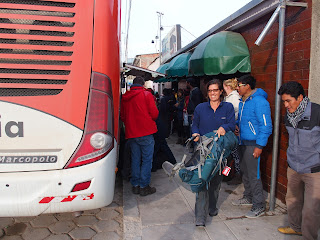To Chopika, Bolivia
We all seemed to have slept pretty well on our super fancy bus. We learned later that the accommodations downs stairs were slightly better than those upstairs where there were four seats across vs only three downstairs.
Just as we hopped off the bus at 7 a.m., a man met us and quickly loaded our packs into a nearby Land Cruiser. Hilariously, almost every vehicle in town is a Land Cruiser or maybe a Forerunner. In so many of the countries we’ve traveled -- Africa, Southeast Asia, and here in South America -- Toyota definitely seems to have a lock on the market.
After an uninspiring breakfast, we wandered over to the main plaza to buy some cheap sunglasses and a hat for Kylie. Our tour began in the Land Cruiser at 10:30 with the four of us with a young backpacker from England, Adam, and a young nurse from Peru, Noela.
Just outside town, our first attraction was a railroad graveyard where we stopped to climb and play for a while. When the nearby Potosi silver mine was no longer profitable, it closed. The trains were abandoned and left to rust.
The rest of the day was spent exploring the massive salt flats, the primary attraction here (with about thirty other Land Cruisers). Fortunately, there is lots of space to spread out. Even with partly cloudy skies, we were all happy to have sunglasses. Looking at the endless expanse of the salt flats, it was easy to imagine we were sailing across a huge flat ocean or gigantic frozen lake. Bemar, our guide, explained that the salt flats were created from a 40 million year old lake. Today the ancient lake bed is 120 m deep (almost 400 ft) composed of, not only sodium, but lithium, potasium, magnesium, and other minerals.
Later, as the sun was getting low in the sky, we suddenly came upon Fish Island, an island of land in the sea of dry salt. Apparently, the island was originally a coral outcropping in the ancient sea, now covered with gigantic sagraro-like cactus. It was really cool to gaze out over the lake bed from the top of the island.
Our final stop, where my external phone battery met its watery demise, took place just as the sun was setting. Bemar insisted that we all get out and slowly walk through the water with the almost perfect reflection of us and the reddening sky. Half way through the video, he flipped the camera so it was our reflections that we're doing the walking.
Just a few miles away were our accommodtions for the night, a simple hotel constructed almost entirely of salt blocks and with a floor downstairs of loose salt granules. Nevertheless, it was quite nice, giving us a comfortable evening to a very long day. Dex headed back to the room after dinner. Five minutes later, when we returned to the room, he was already asleep with the lights on.





























Bolivia looks absolutely incredible
ReplyDeleteFun everything in this blog. What a wonderful world.
ReplyDelete